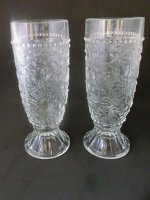You are using an out of date browser. It may not display this or other websites correctly.
You should upgrade or use an alternative browser.
You should upgrade or use an alternative browser.
They look young
- Thread starter 911car
- Start date
KAGGR#1
Well-known member
Bruno
Very nice photo
I did not know that you were also a collector of photos
Thanks
Steve
John Josef
Well-known member
Cool photo and thank GOD for German Bier Culture at least they were able to enjoy a nice Bier before going to war.
Not really, Steve, but I like photography in general. When a nice WW1 related one comes into sight I may try not to miss it.I did not know that you were also a collector of photos
Gunner who?
Member
Very interesting picture - some Tschapkas have chinscales, others do not.
Cheers
Cheers
CLOVIS 57
Well-known member
Very interesting picture - I can see my beer glasses in it, champagne flute style!
These glasses were found on the battlefields by villagers in the Verdun region just after the war, and were widely used at the time, as everything was in short supply in the disaster zones. Farmers went out to plough, wearing German boots! This is the case here, given their condition.
We still find them today, in digs, in “dustbins”, but in this case they are often broken, or iridescent and scaled.

These glasses were found on the battlefields by villagers in the Verdun region just after the war, and were widely used at the time, as everything was in short supply in the disaster zones. Farmers went out to plough, wearing German boots! This is the case here, given their condition.
We still find them today, in digs, in “dustbins”, but in this case they are often broken, or iridescent and scaled.
CLOVIS 57
Well-known member
Yes, a photo that proves that when war broke out, anything was possible to equip the soldier: M94 chinstrap for parade (with scales), chinstrap with leather strap, in natural leather (brown) or patent leather (black). Note the difference in strap length, due to the different spacing of the sliders.Very interesting picture - some Tschapkas have chinscales, others do not.
Cheers
And some of the chinscales look too short, that is, sitting too high on the eagle plate. Seeing the same on a Tschapka nowadays, many a collector (including myself) would conclude that the chinscales are not original to that helmet...Yes, a photo that proves that when war broke out, anything was possible to equip the soldier: M94 chinstrap for parade (with scales), chinstrap with leather strap, in natural leather (brown) or patent leather (black). Note the difference in strap length, due to the different spacing of the sliders.
Right. And on some of them the guard eagle is missing the Suum Cuique star. Does it mean those are M15 models? I have never seen a brass eagle missing the star on a Tschapka.Very interesting picture - some Tschapkas have chinscales, others do not.
Cheers
KAGGR#1
Well-known member
All very interesting pointsRight. And on some of them the guard eagle is missing the Suum Cuique star. Does it mean those are M15 models? I have never seen a brass eagle missing the star on a Tschapka.
Steve
CLOVIS 57
Well-known member
Exactly.y) In fact, the length of the scaled part depended on the size 1-2-3 of the hulls. So that, in the resting position (with the fastening button), it's positioned just under the faceplate, roughly under the separation with the visor.And some of the chinscales look too short, that is, sitting too high on the eagle plate. Seeing the same on a Tschapka nowadays, many a collector (including myself) would conclude that the chinscales are not original to that helmet...
But that was just for “Garniture 0” helmets, i.e. helmets delivered new for parade use. After mobilization, all these rules were abandoned in view of the urgency of the situation, and the “Garnitur Feldbrauchbar” came into general use.

